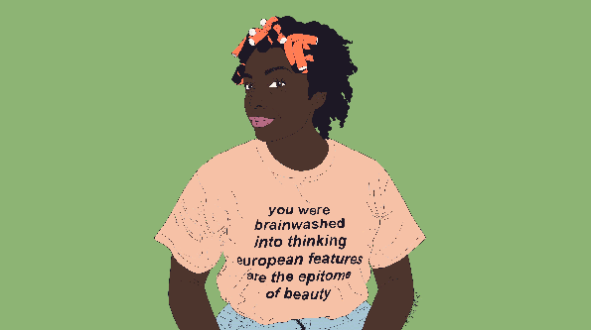Maggie Hazen’s video piece, Hulk, and text piece, Embodied Imaginary: From Gendered Bodies in Virtual Spaces to Powerful Bodies in a Physical World, both examine the virtual realities of the gaming world. By inserting herself into the imaginary world of the video game Hulk, she overcomes the barriers of real life expectations on her gender and sexuality by re-imagining herself in the way she wants–defying the standard notion that masculine figures are essential in gaming performances. The “virtual environment,” Hazen states in her written piece, “must not construct its critical edifices upon an uninterrogated mythologization of gender and sexuality as they stand, but rather remake the world as we wish to see it.”
:::
The ways in which we imagine the technologies of the future can speak volumes about our concerns in the present. More specifically, we might say that prospective techno-scientific advances illuminate the perceived horizons of political possibility. How might we intervene within these developments in order to articulate a more emancipatory future, free from perceived gender and sexuality norms? We are always in the act of becoming something else, and technological mediation makes this even more so. Virtual bodies, cyborg bodies, and queer bodies promise un-fixed identities. But who is in control of these bodies? Are they controlled by a fiction we author via action cinema, video games, war narratives? The future we speculate about is uncertain and open for change. We must be careful of the mythologies and narratives we construct through technology as they will inevitably schematize our designs for a post-human future.
In massive multiplayer online role-playing games (MMORPGs) a person can create an avatar completely distinct from one’s self. These interactive virtual environments enable real-time interaction with fictional, visual landscapes. Such uncertain spaces propose a fiction that originates in the imagination—constructing a hybrid space where the virtual self becomes the real self. Here, people play out their desires to become different versions of themselves. Very often, it is the masculine, militant superhero and warrior characters performed in virtual spaces that serve as place-holders until other versions of selves can be developed. It is these often violent characters that are constructed and integrated into the physical body.
Literary critic Katherine Hayles defines “virtuality” as “the cultural perception that material objects are interpenetrated by information patterns.”[1] Virtuality is associated with computer simulations that put the body into a feedback loop with a computer-generated image. However, in full-immersion VR, one perceives being physically present in a non-physical world. The degree to which the virtual or artistic environment consistently reproduces reality determines the degree of suspension of disbelief. The greater the suspension of disbelief, the greater the degree of immersive presence achieved.
Recent developments in virtual technology and software have accelerated the fluidity between control and response movements in video games to such an extent that the distinction between the real and the virtual has begun to collapse. In video game environments, gamers’ physical bodies are not fully immersed in an environment but can be connected to the virtual by fingertips, arm movements, eye movements, voice, and other sensory organs to the extent that the mind embodies a virtual organism. Game-like simulators used by the US Army root the virtual in reality. In 2014, Army News Service announced that the future of the US Army’s training environments will feature live holistic synthetic combat training, which integrates various simulations into a single, remotely accessible system.[2] Enemy jets will be piloted from 2 a thousand miles away by soldiers, some in aircraft simulators and others on computer gaming stations. Gaming is not yet officially part of the Army’s simulation syllabus but is expected to be soon. The sensory distinction between the virtual and the real is certainly becoming thinner, which has obvious consequences for “players” mistaking the real for the virtual and vice-versa.
According to Ernest W. Adams, an author and consultant on game design, immersion can be separated into three main categories: tactical immersion, strategic immersion, and narrative immersion.[3] Players feel tactically “in the zone” while perfecting actions that result in success. Strategic immersion is more cerebral, and is associated with mental challenge such as in playing chess. Narrative immersion occurs when players become invested in a story, and is similar to the experience of reading a book or watching a movie. Staffan Björk and Jussi Holopainen, in Patterns in Game Design, divide immersion into similar categories and add a fourth—spatial immersion—which occurs when a player experiences a simulated world that is perceptually convincing.[4] The player feels that they are truly “there” and that a simulated world looks and feels “real.”
Grand Theft Auto (GTA) promises “special immersion” in that the game’s simulation of human activity is rendered in the highest possible detail. In GTA, the player can switch from standard third-person to first-person role playing. This mode provides an entirely new perspective in this notoriously violent game, as killing other characters becomes a personal, visceral experience. First-person killing in games such as Call of Duty, Halo, or Full Spectrum Warrior pales in comparison to the gruesome verisimilitude of GTA. With practice one can gain complete tactical authority over the carnage. Gaining that authority can be tremendously fulfilling, but to conflate mastery of a system’s rules with mastery of the real world is problematic to say the least when it comes to killing people.
Mentalization is the ability to reflect on the emotional states of oneself and others.[5] We “mentalize intuitively when we interact with other people, on a gut level, in the give and take of a reciprocal social exchange.” Mentalization “regulates affect” and further, “gives us the ability to distinguish between inner and outer realities.”[6] This basic human capacity, essential to our ability to distinguish internal thoughts and feelings from external worlds, evolves from the more primitive mental state of “psychic equivalence,” in which the distinction between internal and external realities is confused or conflated.[7] When a person loses mentalizing capacity and retreats to psychic equivalence, feelings of shame and humiliation can be experienced as real, as an actual threat to individual identity. Violence can ensue as a mentally justified form of self-defense.[8] Clearly losing the distinction between inner and outer realities is endemic to the virtual world. I call this effect— where depictions of fantasy on screen bleed into our depictions of reality—“hyperbleed.”
A non-violent example of hyperbleed would be those who go to great lengths through plastic surgery to become a real-life version of a simulation. Herbert Chavez, 37, underwent nineteen surgeries over sixteen years to look like Superman. In an interview with the Daily Mail, he suggested his ultimate ambition: “If you talk about super heroes, the expectation of people is that they are flawless, they do not get hurt, they do not die.”[9] Or Pixee Fox, 25, who had fifteen surgeries and six ribs removed to look like Jessica Rabbitt. These hyper-masculine and hyper-feminine extremes point to a psychological state in which one identifies entirely with a fictionalized depiction of an ideal human. What is the motivation to achieve such a state? Is there a universal fictionalized desire to manifest a power greater than what can be achieved in reality?
Hyper-masculinity typifies the physical models for humanoid robotics as much as virtual personas. Iron Man has in fact arrived in the form of a super suit being invented in Japan. HAL, or Hybrid Assisted Limb, a powered exoskeleton suit developed by Japan’s Tsukuba University and the robotics company Cyberdyne, is designed to support and expand the physical capabilities of its users, particularly people with physical disabilities. When a person attempts to move their body, nerve signals are sent from the brain to the muscles through the motor neurons, moving the musculoskeletal system. This type of exoskeleton is defining a new class of warrior, a real Iron Man.
In a 1995 interview, the scientist Manfred E. Clynes—the man who coined the word “cyborg”—discussed the ways in which various everyday technologies contribute to a “human enlargement of function.”10 He argued that when we do something as commonplace as putting on a pair of spectacles, or learning to ride a bike, we in fact become a “simple cyborg.” Today, we have come much further of course. Cultural theorist Scott Bukatman has argued that we are at a time in which “the obsessive restaging of the refiguration of the body posits a constant redefinition of the subject through the multiple superimposition of bio-technological apparatuses. We’re at the time now where we have to start redesigning the human body to match the technology we’ve created.”[11]
What kind of body will this be? Clynes has suggested that cyborgs do not disrupt the binary gender system, and insists that cyborgian adaptations have no impact upon a person’s “essential” sexual identity.[12] But how can we deny that masculine interfaces are shaping the narratives and identities built into our machines? It is essential to consider how we are gendering technology and aim to actively shift the conversation we are currently imagining around speculative fictions and other narrative worlds. The virtual environment must not construct its critical edifices upon an uninterrogated mythologization of gender and sexuality as they stand, but rather remake the world as we wish to see it. Such reimagining could reshape our technopolitical future.
Notes:
[1] Katherine Hayles, How We Became Posthuman: Virtual Bodies in Cybernetics, Literature, and Informatics (Chicago: University of Chicago,1999), 13–14.
[2] David Vergun, “Live Synthetic: Army’s next Generation of Simulation,” ARMY.MIL, The Official Homepage of the United States Army, n.p.,
March 19, 2014.
[3] Ernest Adams, “Postmodernism and the Three Types of Immersion,” July 9, 2004; on Gamasutra.com.
[4] Staffan Björk and Jussi Holopainen, Patterns in Game Design (Boston: Charles River Media, 2004), 206.
[5] Molly S. Castelloe, “How Holding a Gun Inhibits Mentalization,” Psychology Today, January 20, 2014.
[6] Ibid.
[7] Ibid.
[8] Ibid.
[9] Imogen Calderwood Mailonline, “Superman Wannabe,” Daily Mail Online, June 29, 2015.
[10] Manfred E. Clynes (1995) “An Interview with Manfred E. Clynes” conducted by Chris Hables Gray, in Gray, Chris Hables (ed.), The Cyborg Handbook, New York and London:Routledge, 45.
[11] Scott Bukatman, “Postcards from the Posthuman Solar System,” Science-Fiction Studies 18 (1991), n.p.
[12] Manfred E. Clynes (1995) “An Interview with Manfred E. Clynes” conducted by Chris Hables Gray, in Gray, Chris Hables (ed.), The Cyborg Handbook, New York and London:Routledge, 51.
:::
 Born and raised in Southern California, Maggie Hazen (b.1989) is an interdisciplinary artist and performer based in New York city. She received her MFA from the Rhode Island School of Design and has done collaborative research at NYU, CERN, MIT and Brown University. Hazen’s work investigates the role of women in technological advancement by relating to the female body as an alien form.
Born and raised in Southern California, Maggie Hazen (b.1989) is an interdisciplinary artist and performer based in New York city. She received her MFA from the Rhode Island School of Design and has done collaborative research at NYU, CERN, MIT and Brown University. Hazen’s work investigates the role of women in technological advancement by relating to the female body as an alien form.
Her solo exhibitions include Brown University’s Granoff Center (2016); and the Los Angeles Museum of Tolerance (2012) for the 20th anniversary of the 1992 LA Riots. Her group exhibitions include OBO: RISD M.F.A Sculpture 2016, Microscope Gallery, Brooklyn, NY (2016); A Sponge and A Sigh, Museum of Human Achievement, Austin, TX (2016) and The Boston Young Contemporaries, Boston, MA (2014). Hazen has done collaborative research at CERN, MIT and Brown University. She most recently to studied at the European Graduate Studies in Saas-Fee Switzerland to research art and the politics of estrangement where she also exhibited her work. Her residencies have included Vermont Studio Center (2016) and a collaboration with Pasadena Side Street Projects (2014).



